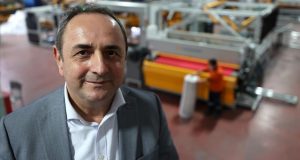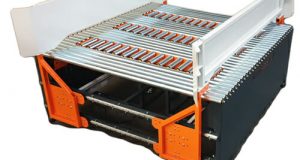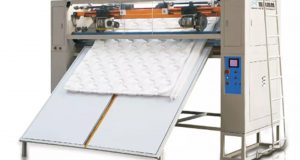In the luxury-bedding world, the focus shifts from construction to materials. Not only do most mattresses look alike, but also their essence — the components that distinguish well-made models from lesser ones — is hidden
Mattresses with stabilizing interior springs, probably the single most significant advance in mattress design, were first developed during the mid-1800s. By placing a set of uniform springs inside layers of upholstery, mattress manufacturers could imbue their product with a firm, resilient, and uniform texture. It was not until after World War I that innerspring mattresses were mass-produced by Zalmon Simmons, Jr., the president of a company that had theretofore produced bedsteads. Many of the textile machinery manufacturers have been manufacturing some quilting or mattress machines especially in Europe. In Turkey, mattress machinery manufacturers are generally dominating on full lines of mattress machinery and there are some good and prestigious names such as Ümit Makine, Mert Makine, Elektroteks, Veysel Kütüklü, Katermak, etc. When we look at the world we see some manufacturers’ names most common such as MPT Group, Black Bros, Masias Maquinaria, Mammut, Albrecht, Amelco, Atlanta Attachment, Global Systems Group, Edgewater Machine, etc. The latest terminology for contemporary and innovative mattress machinery have features such as being “multifunctional,” “nimble” and “digital”. Still, the machines from the previous generation are still widely in use. The way beds are built has changed significantly thanks to advances in machinery. Assertive and competitive companies have been trying to develop new high-speed, problem-solving machines that make building today’s more complicated mattresses. Stretch knits, memory foam and gel foam all are components that got their start in specialty sleep, but now are commonplace in innerspring models, as well. Each poses particular challenges to mattress manufacturers, and machinery companies have worked hard to find solutions through decades.
Innerspring – the basic unit of mattress
Innerspring is the basic unit of a mattress. A foundation mattresses or boxsprings lie directly beneath the mattress, resting on the frame of the bed. There are different varieties of boxsprings. In some of them, spiked coil configuration is used where there is a spring system while torsion bars are used for giving support in others. In yet another type of boxspring, no springs at all are used and it consists of a built-up wooden frame. From among these, the boxsprings having spiked coil design are the most common ones. The spiked coil design boxspring is made by attaching the bottom of each coil to a flat wooden frame. A wire grid is placed on top of the springs in an aligned manner and is locked manually. A thin layer of upholstery is attached at the top. If, however, the intended boxspring contains no springs, it consists of a wooden frame that may or may not have a layer of upholstery attached to its top. The frame is usually inserted into a pre-sewn cover that encases the top and sides of the unit, regardless of the internal composition. A matching fabric border is applied to the sides, and a dust cover is also added to the face. In most of the cases, a mattress manufacturer does not make the innerspring units. The work is outsourced and these units are made by the specialized firms. Once these completed innerspring units are received, the work of at the mattress factory begins. The textile furnishing layers are affixed to the innerspring manually. There are essentially two uphol – stery layers, the insulator and the cushioning layers. The insulator is affixed directly onto the innerspring and prevents the next layer, the cushioning layer, from molding to the coils. While the insulator used is almost standard, the number of cushioning layers differs widely in number. These cushioning layers range from two to eight layers and from a quarter inch to 2 inches (0.63 to 5 cm) in thickness. These cushioning layers determine the feel and comfort of the end product. The core mattress is given an attractive exterior by decorative mattress cover. The cover is manufactured with the help of quilting machines having a multitude of needles that stitch the cover to a layer of backing material. The quilted fabric is cut into panels that are attached to the top and bottom of the mattress. The side panels are often cut from the same quilted fabric but sometimes it is made separately on a border machine. Flanges are the connecting panels that are attached to the quilted cover of the mattress with the help of hogs rings which are large, round staples. The flanges are attached to the top and bottom panels with the help of a special – ly modified sewing machine and the hogs’ rings are stapled to the flanges. During the closing opera – tion, the hogs’ rings are secured to the innerspring unit. Closing operation is very critical which needs highly skilled execu – tion. A movable sewing head that is mounted on a track is used for the closing operation. The Tape edge operators manually feed the top, bottom, and side panels and a heavy duty binding tape into the sewing machine as it moves around the mattress. It highly depends on the skill of the opera – tors to feed just the right amount of each material into the machine in order to get the end product of a professional standard. Some of very high quality mattress – es may also have a pillow-top on them. A panel filled with soft uphol – stery is attached to the top panel of the mattress. Pre-quilted pillow top is, then, taped to the mattress.
 SleepTech Magazine Mattress, Accessories, Machinery, Raw Materials
SleepTech Magazine Mattress, Accessories, Machinery, Raw Materials


